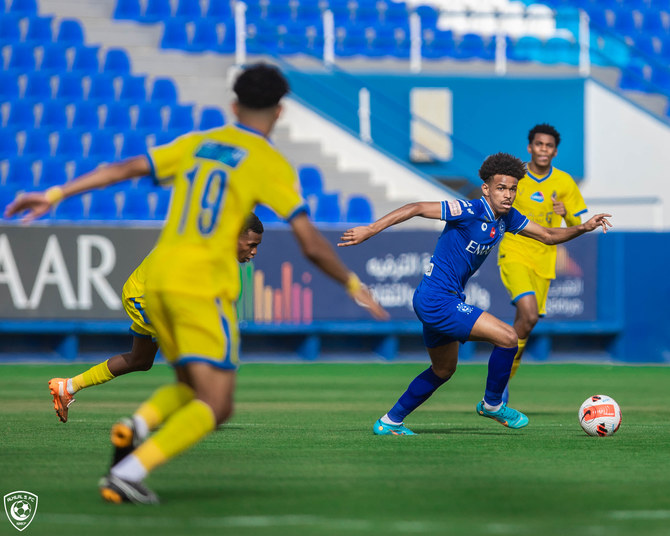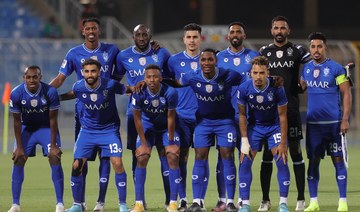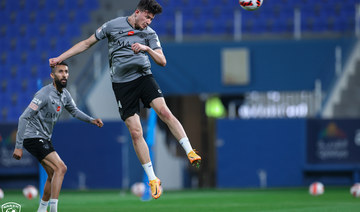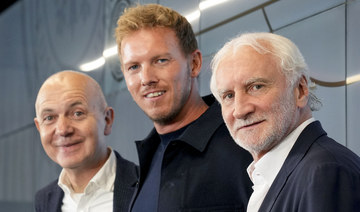The latest round of games in the Saudi Professional League was postponed as a mark of respect to UAE President Khalifa bin Zayed Al-Nahyan who passed away on Friday.
It meant that the Saudi Classico, the big clash between leaders Al-Ittihad and second-placed defending champions Al-Hilal, will have to wait a little longer.
The dates have changed and this could cast a different light on the title race. Now the rivals from Jeddah and Riyadh will meet on May 23. As a reminder, the gap between the two is six points with four games remaining. If Hilal win, then the pressure will be on Al-Ittihad for the first time since they went top of the league and started pulling away. Then the fight would really be on for the final three games of the campaign.
That can still happen, but now with a difference. Before the rescheduled title decider, Al-Hilal will first have to take on Al-Fayha in Thursday’s King’s Cup final.
This adds an extra dimension to the title race. The champions would surely have preferred to face Al-Ittihad first, cut the lead to three points and then let the leaders deal with that. Now however, they have to play a prestigious — as well as emotionally and physically draining — cup final just four days earlier and then go straight into the biggest league game of the season.
And the King’s Cup final is sure to be a big deal. It is the first chance for Al-Fayha to win a major trophy. The club are in sixth place in the league and are not going to finish any higher than that. Relegation is not an issue so they can focus all their energies on the game.
“If you look at how we play then you can see that we are a difficult opponent for the big teams,” said Al-Fayha coach Vuk Rasovic. “We will do our best to make our fans happy. The King’s Cup final is a very special match for us.”
Rasovic’s men are not to be underestimated and showed that by defeating Al-Ittihad in the semi-final. The Tigers, who are aiming to win the league for the first time since 2009, may now be quite happy with that elimination. Al-Hilal are favorites to emerge victorious but it is going to be a battle and extra-time and penalties are certainly not out of the question. There is also the risk of more injuries to a team that already has a number of players in the treatment room as the league campaign reaches a climax.
For Al-Hilal, the situation is now a little similar to Liverpool’s in England. The Reds have been chasing Manchester City at the top of the English Premier League, but on Saturday had to play the FA Cup final against Chelsea. They ended up winning that game but it was a grueling and hard-fought 90 minutes, followed by extra-time and then an emotional penalty shootout triumph. Liverpool are now scheduled to play Southampton on Tuesday in a game that they have to win if they are going to keep their league ambitions alive. They then end the season at home to Wolves on Sunday. This congested fixture list is made more difficult by Mohamed Salah and Virgil van Dijk leaving the Wembley pitch with injuries on Saturday. But while the knocks don’t seem too serious, they were worrying moments for coach Jurgen Klopp and the fans.
All of these issues leave Ramon Diaz with plenty to think about. Had the final come after the Al-Ittihad game, then the Argentine would have a clear vision on his team’s chances for the title. Now, he needs to do all he can to win the King’s Cup and hope that this does not derail Al-Hilal’s slim chances of the league.
In some ways, having so many big games is a reflection of Al-Hilal’s success but Al-Ittihad will be much the fresher of the two teams when they meet in Jeddah next week and that could make a huge difference, especially in the closing stages of the match.
There are pressures at the bottom of the table too. The relegation battle is fierce, with the bottom half of the table all in danger. Al-Taawoun will be happy they played before the postponement came into effect and won their crucial six-pointer against Al-Batin. That dragged Al-Ettifaq into the bottom three but they are expected to defeat Al-Hazem, the only team adrift at the bottom. Al-Faisaly lost on Thursday and will be watching other results anxiously. The extra days have given teams a little more time to rest ahead of a crucial few weeks — all except Al-Hilal, who have big game after big game.
What was already a long season has become a little longer and will now run from August to June. There have been plenty of stops and starts with breaks for the successful World Cup qualification campaign and various Asian Champions League games. It can’t have been easy for the players but there is still plenty of excitement for the fans, starting with the King’s Cup final on Thursday and a potential title decider just four days later.





















